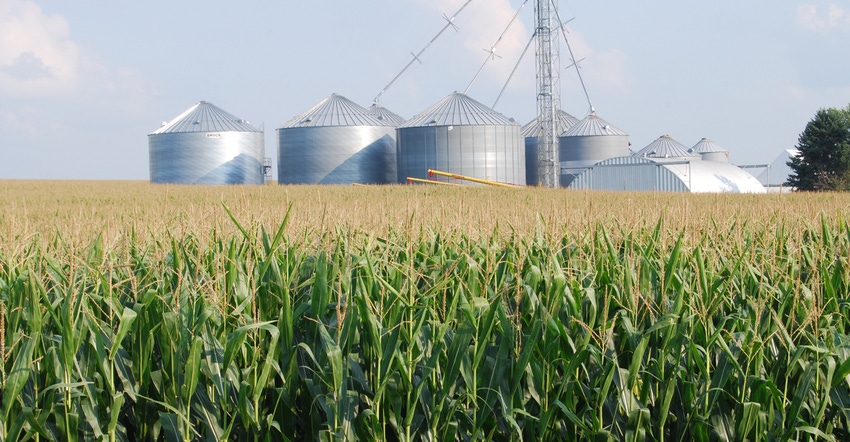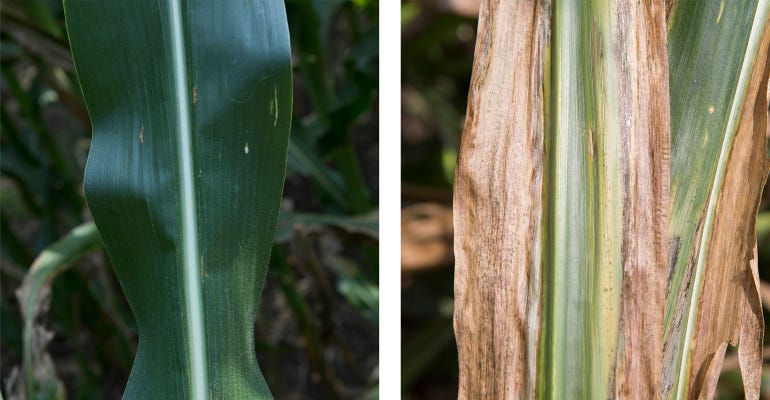July 22, 2019

A fungicide application is one of the last cropping and input decisions many Iowa farmers can make in August to influence yield of the 2019 crop, beyond continued prayers for favorable weather. In addition to yield protection, fungicide applications improve standability and havestability, which have a high probability of paying off this year as late planting will likely result in a late harvest.
Since the 2015 northern corn leaf blight outbreak, much of the state has continued to experience weather conditions conducive to disease pressure, and 2019 is no exception. “Cool and wet conditions, along with heavy rains splashing soil and inoculum directly into the canopy, have set us up to have a heavy disease year,” says Nicole Stecklein, a Dekalb/Asgrow technical agronomist serving northeast Iowa.
Gray leaf spot, a major disease of corn in Iowa, has been identified in the mid-canopy of pre-tassel corn since the first week of July. This timing is unusual, as leaf diseases typically do not start to infect much of the crop until reproductive stages have been initiated. Other diseases to be on the lookout for are northern corn leaf blight due to high inoculum loads in the past and southern rust because of its aggressive nature late in the season. For the northeast portion of the state, also be on high alert for tar spot, a new disease in Iowa that has the ability to greatly reduce yields.
Scouting diseases
Correctly identifying which diseases are present helps determine if a fungicide will be effective. For example, Goss’s wilt and bacterial leaf streak, both easily confused with northern corn leaf blight and gray leaf spot, respectively, are bacterial diseases and therefore will not be affected by fungicides.
“Scouting and identifying diseases, while very important, is not the only factor when considering whether to spend the dollars,” says Stecklein. “Particularly for 2019, assessing the yield potential of the field in question is paramount. Fungicides only have the ability to protect existing yield potential, not add to it, so identifying other limiting factors such as nutrient deficiencies is crucial.”
Disease prevention is the best way to save yield from the stress of an infection, she adds. “So, while scouting is an important aspect of the decision, we also need to be aware of the long-term weather forecast trend and if it is favorable for disease development. Field history can also add clues as to the profitability of an application. Corn-on-corn fields will typically have higher disease pressure and higher fungicide ROI than rotated fields, especially if certain fields were known to have higher disease incidence in the past.”
Hybrids differ in response to fungicide
Regarding concerns about drydown, there is typically a small difference in grain moisture early in harvest. As corn grain dries to the mid-low 20s, differences are typically not seen. Hybrid selection also plays a role in decision-making.
“Some corn hybrids respond well to fungicides even with very low disease presence,” Stecklein says. “Others have a very high disease tolerance, and the ability to continue to produce yield even when infected. This information should be available through your seed dealer.”

RESISTANCE: A corn plant with Dekalb Disease Shield genetics (left) has enhanced protection against Goss’s wilt compared to a nonresistant corn hybrid (right).

The most profitable timing window can vary year to year based on when disease develops, and if the weather is more favorable for disease development early or late in the grain fill period. Overall, the best timing for fungicide applications are between VT (full tassel) and R3 (milk stage). “If applications will be made before a field reaches full tassel, remove any surfactants from the tank to prevent arresting ear development,” she advises.
If fields have moved past the R3 stage of corn development, continue to scout and make notes for management planning in the future. “If you identify fields with high disease pressures, consider planting a Dekalb Disease Shield product in 2020,” Stecklein says. “Corn hybrids with Disease Shield protection have been identified as having above-average resistance to the top five corn diseases in Iowa: anthracnose stalk rot, Goss’s wilt, gray leaf spot, northern corn leaf blight and southern rust.”
Source: Dekalb, which is responsible for information provided and is wholly owned by the source. Informa Business Media and its subsidiaries aren’t responsible for any content in this information asset.
You May Also Like




